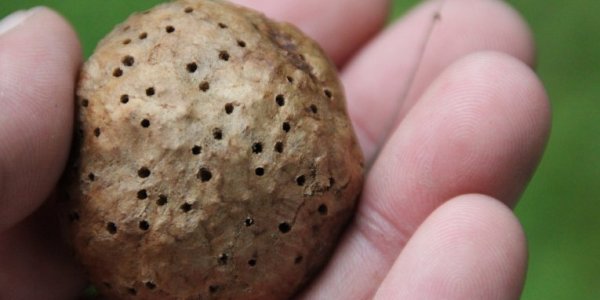Apples in oak-tree foliage
Taking a closer look at oak-tree trunks, the lucky will notice insects, which at first glance resemble ants which are creeping upwards the tree trunk. These animals are 3.5 - 6.3 mm long, yellowish-brown or reddish-brown, wingless, with "antennae" on their heads. They are not ants, but biorhiza pallida - gall wasps - cynipidae family insects with a very unusual course of development.
Like for many other cynipidae species the life cycle of biorhiza pallida includes two generations: same-sex generation formed by females able to multiply partenogenetically (the so-called summer generation), and gametophyte consisting of both males and females (the so-called winter/ spring generation).
Representatives of the same-sex generation - wingless, reddish, partenogenetic females - are the ones climbing up the trunks of oak-trees in early spring. Once they reach the crown of a tree, they are moving to fine twigs, seeking for leaf buds where to lay their eggs (several dozens in each bud). At the same time gall wasps inject their salivary gland secretion into buds to soften and swell the plant tissue.
In April, the buds traumatised by gall wasps instead of leaves, form abnormal growths - called the galls. Their task is to become a safe haven for insects and a larvae feed. After the larvae hatch, they develop auxins, which stimulate enrichment of galls with tannin substances. It is leading to a number of biochemical reactions promoting extensive plant tissue growth.
Already in May, there are several sizeable "apples" (3cm to 5cm, rarely up to 6 cm in diameter) in the oak leafage. Galls have grown. Their shape is irregularly round, with uneven surface; their colour is usually yellowish or pale pink. The young galls are soft, their structure - porous. In the inner part of the formations there are many chambers, each of which is home to one gall wasp larva. The gametophyte or winter/spring generation is developing. Usually in one gall there are no larvae of both sexes - future males or females tend to live together, but it is not a dogma.
The formation process of the animals in the unusual “nurseries” lasts for 2-3 months: first there are eggs, which turn into the stage of larvae, followed by pupation, development of the pupa and in the end - the break of the pupa. After the break of the pupa the already adult, sexually mature insects gnaw through the gall pericarp. In Latvia, usually it happens in late June or early July.
No longer used or needed, the perforated galls gradually dry up and become brown, and later black; the structure of the formation becomes similar to paper. This way they remain in oak-trees for a long time, often - until late winter or even spring. The galls turn brown and dry up also if during their development, animals for some reason have died; however, in such cases the galls do not have bore holes
The small diameter of the holes of the galls productively used shows that the adult specimens of biorhiza pallida gametophyte are not particularly large. The length of these insects as compared to sporophyte gall wasps is small, ranging from 1.7mm to 3.5mm. Females are slightly larger than males, who have developed in similar conditions, and with visibly more corpulent bellies, darker eyes. The colour of the animals that may be seen in summer is similar to that of the spring animals - golden brown. Gametophyte gall wasps have wings (wings of females are shorter than of males).
Gametophyte insects, of course, mate. After copulation the males, having accomplished their task, can rest in eternal sleep, while the females let ripen the eggs, land on the ground beneath the oak-trees, dig into the ground, where they usually search for fine (usually annual) tree roots, and lay their eggs into their bark - one by one. Irregularly round, reddish or brown, juicy single-chamber galls (5-10 mm in diameter) form in the place of the lay.
If several eggs are laid closely side by side, their galls may coalesce together. The future sporophyte biorhiza pallidas live in these formations.
The larval development process lasts until autumn, followed by the pupation stage. In late autumn or next spring partenogenetic females break the pupa and come out of the root galls. The insect "virgins" climb up oak-trees to search for leaf buds. The cycle has started anew.
The gall wasp is a relatively little studied hymenoptera order of insects. There are 25 species of these insects living in Latvia. The majority of these species are herbivore (galls made by gall wasp larvae can be found both on different trees and shrubs, as well as on herbaceous plants); however, larvae of some species of gall wasp are parasites. A great part of the herbivore gall wasps prefer oak-trees.
The best known gall wasps living in Latvia: diplolepis quercus-folii, neuroterus quercus baccarum, cynips longiventris, andricus fecundatrix, biorhiza pallida.











